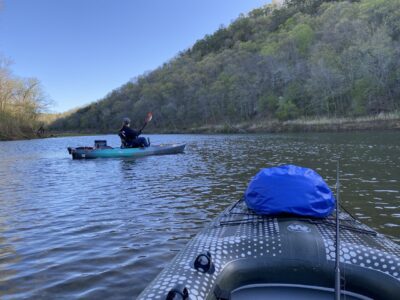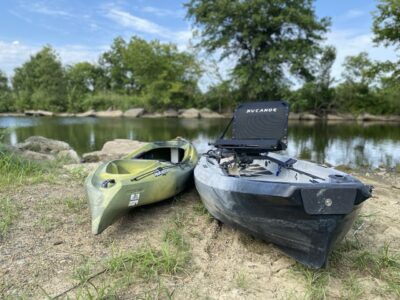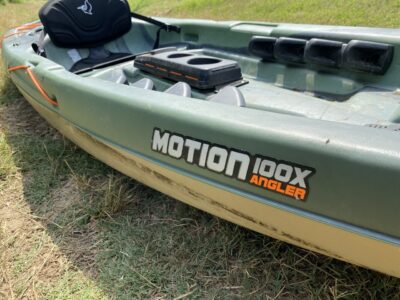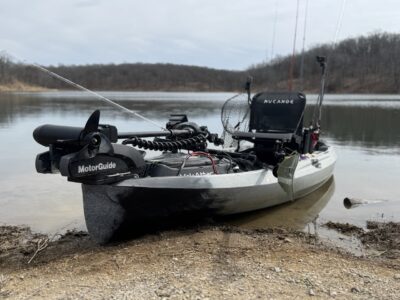
Wesley Littlefield 04.17.25

When I first began kayak fishing, not many fishing kayaks were available, but times have changed. New kayak anglers can quickly become overwhelmed by the number of fishing kayaks on the market. Learning how to choose a fishing kayak will reduce stress and make fishing trips more enjoyable.
After testing hundreds of kayaks and buying several over the years, I’m giving away the secrets and factors I use to buy the perfect fishing kayak every time.
Understanding the Different Types of Kayaks

Not only are there loads of fishing kayak models, but there are also different types of manufacturing processes, styles, and propulsion options. Let’s break down the most common occurrences to help you make an informed decision.
Rotomolded vs. Thermoformed vs. Inflatable vs. Foldable
Most fishing kayaks you’ll want to consider are rotomolded because they’re durable and require less maintenance. Rotomolded kayaks are a solid piece of plastic, so you don’t have to worry about a seam coming apart.
Thermoformed kayaks are made of two pieces of plastic (the hull and deck or top and bottom) joined by adhesive and tape. This type of kayak is less durable (more prone to separating at the joint/seam) but often more lightweight.
I was very skeptical of inflatable kayaks at first. I thought they would pop the first time I dragged them across a rock or stabbed them with a stick. After testing a few different models, I can confidently say I love my iAtak 110 because it’s more durable than I thought it would be, was designed for fishing, and is more portable than a hard-sided kayak.
A foldable kayak is also easy to transport. Though they’re not specifically designed for fishing, the ones I’ve tested are durable and easy to paddle.
Sit-In Fishing Kayaks vs. Sit-On-Top Fishing Kayaks

Fishing kayaks are most often classified as sit-in or sit-on kayaks. After using both, I prefer the sit-on-top variety for many reasons, but that doesn’t mean a sit-in kayak isn’t right for you.
Sit-on fishing kayaks offer anglers a better fishing experience because many allow the angler to stand and are more comfortable, stable, and customizable.
However, sit-in kayaks are less expensive, lighter, and easier to transport.
Paddle vs. Pedal vs. Power
While all kayaks are designed to be paddled to some extent, several have also been designed to install a motor on or pedal. I started by only paddling but found it frustrating to fish in the wind (it’s always windy in Oklahoma, so I was often frustrated). I then tried using a triller handle trolling motor and found it more enjoyable, but I had to start carrying a battery. My parents love their pedal kayaks (when fishing in our local reservoir) because they offer more control than paddling without sacrificing fishing time.
I recommend testing out each option to see what you like best. Some people would be appalled that I use a trolling motor on my kayak, but I don’t let other people’s opinions stop me from having more fun while fishing.
What to Look For In A Fishing Kayak

Alrighty, now let’s dive into what matters most when choosing a fishing kayak. You’ll have to determine what factors are most important to you. For instance, you might be more worried about weight capacity (safety) than rigability or affordability, more than durability.
Safety
Every kayak angler should focus on safety the most. Safety involves stability, weight capacity, and handling. Kayak stability isn’t just for standing. I’ve fished out of some kayaks where I was worried about tipping, making the trip pretty miserable. Weight capacity isn’t just a concern for larger individuals, especially if you plan to add a motor and lots of gear.
Comfortability
One of the main reasons people object to kayak fishing is that their kayaking experience was with an uncomfortable kayak. Cheaper kayaks tend to be less comfortable, so you might have to compromise here if you’re on a tight budget.
I look for a high-sitting mesh seat because it allows me to stretch and bend my legs better and sweat less.
Durability

Another downside to inexpensive kayaks ($500 or less) is their lack of durability. Since I plan to fish a lot and use my kayak for a long time, I purchased one that should outlast me with minimal maintenance. You will drag it across rocks, logs, and other sharp objects, so get a kayak that can handle it.
Transportability
This was the factor I gave the least thought to because I have a truck and refabricated an old boat trailer. But I would hate to car-top my Nucanoe Unlimited on every trip.
Be sure to think more about how you will get your kayak from point A to point B than I did!
Rigability
Customizing your kayak is part of the fun, at least for me. I enjoy rigging my kayak and trying various things. Some kayaks are more customizable (rigable) than others, so if you want to make the kayak truly yours, get one that you can rig to match your style of fishing.
Affordability
We all have a budget that we must adhere to; some can afford to spend more on higher-end kayaks and accessories than others. I always recommend staying within your budget, but if you’re going to splurge, splurge on a safer, more durable, and comfortable kayak. I did, and I haven’t regretted it.
My Top Fishing Kayak Brand Recommendations

There are many quality fishing kayak brands, but the following are the ones I’ve been most impressed with after testing and fishing out of some of their models.
Last Cast: How to Choose a Fishing Kayak
Now that you’ve learned how to choose a fishing kayak, you’re better equipped to test some out. If possible, try out every model you’re considering on the water. If you plan to primarily fish rivers, test it out on a river or creek; the same goes for lakes and reservoirs. The kayak will perform differently based on the current, wind, and the water body.
Trending Products












